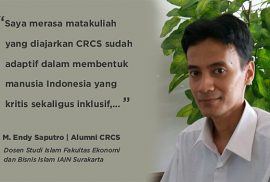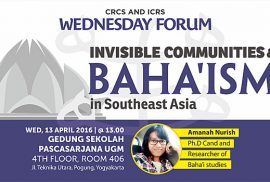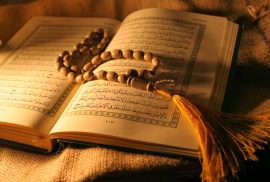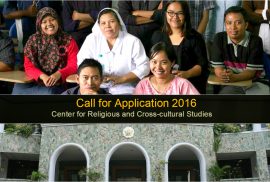Endy Saputro* | Alumni News| CRCS

Sebagai salah satu alumni, saya merasa bangga pernah menganyam pendidikan di Program Studi Agama dan Lintas Budaya (CRCS), Sekolah Pascasarjana UGM. Anyaman tersebut paling tidak telah ikut merajut dua pola kerangka berpikir ilmiah saya.
Pertama, karakter interdisiplin pembelajaran CRCS telah membentuk pola pikir sintesis-kritis-verifikatif saya. Hal ini saya rasakan ketika pindah-kerja di Fakultas Ekonomi dan Bisnis Islam (FEBI) IAIN Surakarta. Semula saya bingung dituntut mengajar matakuliah Metodologi Studi Islam (MSI) di sebuah lingkungan dengan ekonomi kuantitatif sebagai domain studi. Untunglah, CRCS telah mengajari saya bagaimana meramu satu disiplin dengan disiplin lain. Saya pun mulai meracik silabus dengan memposisikan Islam sebagai lokus dan ekonomi sebagai fokus. Silabus saya rancang dengan mengurai tiga kluster paradigma studi Islam: klasik, orientalis dan post-orientalis. Bagian kedua, dengan desain by-research, saya ajak mahasiswa melihat hubungan Islam dan ekonomi. Isu-isu terkini, kali ini terkait ekspresi kelas menengah muslim Indonesia, saya diskusikan dengan mahasiswa. Kemudian, saya minta mahasiswa untuk “turun” ke lapangan melihat apa yang sebenarnya terjadi dalam realitas. Mereka pun segera memadati BMT (Baitul Maal wal Tamwil), bank Islam, rumah zakat, bazar buku Islam, toko busana muslim, halal food expo, dan hotel syariah di kota Solo.
Masih dalam tarikan nafas yang sama, kesadaran mental interrelijius (inter-religious) telah memberi corak semangat-menghadirkan-yang-lain-sebagai-kawan dalam setiap perkuliahan saya. Menurut pengakuan beberapa mahasiswa, di kampus saya yang baru ini, sebagian minor dosen masih suka mengumbar kata “sesat” dan “menyimpang” di hadapan mahasiswanya. Sialnya, sebagian besar mahasiswa sekarang cerdas, dan mempertanyakan sikap dosen yang seperti itu. Kehadiran dosen yang inklusif, alhamdulillah, telah memberikan harapan bagi mahasiswa: masih ada dosen yang berpikiran berbhineka tunggal ika. Hal ini penting saya sampaikan di tengah gempuran reproduksi eksklusivisme di kalangan mahasiswa yang dilaksanakan dengan berbagai varian kontestasinya.
Dari pengalaman tersebut, saya merasa matakuliah-matakuliah yang diajarkan oleh CRCS sudah adaptif dalam membentuk manusia Indonesia yang kritis (nonesensialis) sekaligus inklusif (nondiskriminatif), tentunya dengan tidak tanpa catatan kritis.
Pertama, jika dua anyaman akademis saya di atas hanya dianggap sebagai soft-skills, CRCS perlu mentransformasikannya menjadi sebuah matakuliah. Matakuliah Teaching Religions in Diverse World perlu didesain sebagai matakuliah wajib; bahkan bisa dijadikan alternatif Sekolah Pengelolaan Keragaman, dengan subjek partisipan menyasar dosen-dosen Perguruan Tinggi Keagamaan Islam.
Kedua, saya kira semua alumni sepakat, CRCS telah sanggup menghadirkan atmosfer intelektualitas kelas dunia. Bagaimana kemudian menghadirkan atmosfer ini pada jejaring alumni di seluruh Indonesia. Bagaimana selanjutnya kapital sosial dan kapital budaya akademik CRCS didistribusikan di seluruh pelosok Nusantara. Bagaimana selanjutnya produk mesin-mesin intelektualitas CRCS bisa disebarkan di seluruh Indonesia.
Satu hal hampir terselip dalam ingatan, bagaimana CRCS mampu memberikan sentuhan everyday life dalam setiap matakuliahnya. Everyday religions sebagai subperkuliahan di matakuliah Academic Study of Religions telah menjadi pembuka bagi mahasiswa untuk sadar mencermati kehidupan sehari-hari. Kiranya akan lebih kuat apabila pendekatan-pendekatan budaya populer turut diperkenalkan kepada mahasiswa. Selain itu, riset kuantitatif perlu segera dianyamkan di CRCS agar dapat memperkuat basis kualitatif yang menjadi karakter ilmiah produksi pengetahuan CRCS.
Demikian, semoga dapat menjadi momen untuk mengenang alumni-alumni CRCS yang tersebar di seluruh dunia. Bravo CRCS !!
* Penulis adalah Alumni CRCS angkatan 2006, pernah menjadi koordinator divisi Riset di CRCS. Saat ini menjadi anggota Staf Pengajar Studi Islam Fakultas Ekonomi dan Bisnis Islam IAIN Surakarta.
News

Center for Religious and Cross-cultural Studies (CRCS), Graduate School, Gadjah Mada University proudly announces the call for Thesis Award. The Award is aimed to encourage CRCS students of batch 2015 to write a high quality of master thesis and a publishable article out the thesis on “Religious Education in Higher Education.”
The requirements of the Thesis Award are:

Abstract
The spread of religious millenarianism in the member states of the Association of Southeast Asian Nations (ASEAN) has raised significant questions about religious movement in those countries. The Baha’i religion provides an important case and relevant context as the Baha’i movement has been paralyzed in its country of origin, Iran, since the beginning of the movement in 1844. To avoid persecution and violence, many Baha’i adherents moved to other regions in Southeast Asia. The Baha’i religion is committed to developing educational skills, economic sustainability, gender empowerment, and social movements. Thus, ASEAN encompasses a dynamic and diverse region that aims to provide social, religious, economic, and cultural security for ASEAN citizens. Minority religions such as the Baha’i community, which at the times are victims of conflict and violence, play an important role in achieving those aims. Conversely, religious violence and conflict may be seen as part of the regional deficit in terms of religious freedom and tolerance. In this context, my study tries to examine religious millenarianism and the future evolution of the ASEAN community. The study investigates the co-existence of the Baha’i community with other religious groups such as Muslim, Christian, and Buddhist in their social, political, and cultural negotiations. As the Baha’i engage on some social and political issues in globalization and embrace liberalism and pluralism in the public space, I argue that this study contributes to scholarship in terms of understanding the fate of religious millenarianism in the future of the ASEAN community.
Speaker
Amanah Nurish Ph.D Cand Researcher of Baha’i studies. She is pursuing doctorate at ICRS UGM-Yogyakarta and working as consultant of USAID team-Washington for assessment program, “Fragility and Conflict”. She wrote book chapters, articles, and journals. Her latest publications: Sufism and Baha’ism: The Crossroads of Religious Movement in Southeast Asia (2016, Equinox publisher, London) Perjumpaan Baha’i Dan Syiah Di Asia Tenggara (2016, Maarif Jurnal, Jakarta) Welcoming Baha’i: New Official Religion In Indonesia (2014, The Jakarta Post) Social Injustice and Problem Of Human Rights In Indonesian Baha’is Community (2012, En Arche Journal, Yogyakarta) etc. She received prestigious awards for her academic works such as King Abdullah Bin Abdulazis’s interfaith center-Vienna, SEASREP-Philippine, ENITS-Thailand, Luce & Ford Foundation-USA, ARI-NUS, etc. With her teamwork, she is currently undertaking a broader anthropological research on “ Religious Millenarianism in ASEAN countries” for publication supported by Arizona State University of America.

When it comes to sacred scriptures, among the things that challenge the believers is how to interpret them in ways that are faithful, on one hand, and are aware of today’s context and problems on the other hand. Addressing this issue, on March 29, 2016, CRCS student Azis Anwar Fachrudin interviewed Emanuel Gerrit Singgih, professor of theology at Duta Wacana University. Prof. Singgih taught at CRCS and advised a number of CRCS students’ thesis and is now teaching philosophical hermeneutics and interpretation of sacred scripture at the Indonesian Consortium for Religious Studies (ICRS). Since finishing his Ph.D. at the University of Glasgow, United Kingdom, in 1985, Prof. Singgih has written numerous articles and books which mostly concern Christian theology and interpretation of the Bible, particularly the Old Testament. Among his important books are Berteologi dalam Konteks (2000), Hidup di Bawah Bayang-bayang Maut: Sebuah Tafsir Kitab Pengkhotbah (2001), Doing Theology in Indonesia (2003), Dua Konteks (2009), and Menguak Isolasi Menjalin Relasi (2009).
***
There are several approaches to interpreting the Bible as you elaborate in your book Dua Konteks: dogmatic, historical criticism, literary criticism, and reader’s response. Do you think there is a problem with the dogmatic (or traditional, if you will) approach so that other methods are needed?
Not exactly a problem that will remain unsolved. It depends on how we see the four models in the framework of philosophical thinking. Even the first model (the dogmatic or the traditional model) can be used fruitfully if it is not used in isolation from other factors; for instance, the context of the text and the reader(s). If these factors are seen together, I think the traditional interpretation will not be something considered as bad in the ethical sense, or old-fashioned, or outdated.
Any example? I mean, of the traditional approach isolated from those factor?
If we read Paul’s admonitions in the New Testament, for instance, in the letter to Corinthians, there he said that women should not talk in the congregation. Of course it means that only men can talk. Before I became aware of other models or other hermeneutical understandings, I always said to my students that, well, you can put this text inside a cupboard or inside a fridge, because nowadays there are women who talk in congegrations or are ordained as pastors. So in the Protestant church, how can you reconcile this fact with that text? After I became aware of, for instance, Paul Ricoeur’s explanation of the hermeneutical arcs, I then began to think that maybe it was something done in the time of Paul and maybe he thought that it was necessary at that time to admonish the ladies in the congregation not to talk,because maybe something negative has happened because of that kind of situation.
What was that kind of situation?
There are commentators who think that maybe at that time there were movements which tried to counter the authority of the leaders (who are usually men) inside the congregation, and usually the proponents of these movements were women. Now we have feminist movements; we now do not think of them as negative; instead we understand that women have been oppressed and they should have the right to revolt, and that these movements see the text of Paul as being oppressive to women. On one hand, I agree, but still, on the other hand, I think we have to get a fair picture, following Ricoeur, to try to look at Paul’s reasoning and not immediately regard him negatively. The situation may be negative to Paul, and his reactions could be seen as negative, but still, we have to understand why Paul comes to that kind of admonition.
Doesn’t that imply that modern facts, so to speak, can change the interpretation or the religion itself?
What modernity has achieved cannot be seen as something independent in itself. What people now have achieved has its roots in the past. So, why are we against, for instance, slavery? Because there are people in the past who were already against that. Why are we criticizing Paul? Because at that time there were women who were against marginalization of women. Modernity is a continuation of the past.
I reflect that to what happens in Islam, and I see some ‘reformers’ who do that kind of thinking to the scripture are sometimes regarded as betraying the scripture.
I am not qualified to evaluate my Muslim friends, but, within Christian interpretation of scripture, that has to change, especially when we are now aware of at least four models or alternatives of interperation. We cannot say that any longer. We can say “that is not according to my view of scripture,” but we cannot say “that is not according to scripture.” Because we interpret scripture.
So, interpretation is always relative….
Not necessarily so. What I understand about the scripture is my own view, but it doesn’t mean we cannot find consensus of what is the right interpretation. For me, it is one of the traits of modernity that it is always afraid of losing absoluteness and saying, “If we lose this, we will become relative.” In postmodern thought, people are not going to the relative side, but they are saying that we cannot be absolute; what we can reach is probability, and by looking at probability we can discuss together and hopefully at one time we will find some consensus.
Sometimes I come across some ex-Christian atheists, particularly in the Western discourse, who say that Paul was a misogynist. How would you respond to that sort of accusation?
It depends on what we see as the meaning of the text. If we understand it literally and we cannot do other ways, then of course Paul is misogynist. But who can tell that that is the understanding of the text? I know that sometimes when you wrote your article, you said that this is the understanding and you either agreed or not with that, am I right?
Sometimes, because my audience is mostly conservatives who don’t like obscurity…
I should question the equation between the meaning and the text. By doing that, I try to become postmodernist in the sense that I am not against conservatives as such. In postmodernity we try to go together, and if we can come to some common understanding on the sacred text, I think that is good. And that is what we are trying to look for in lectures such as understanding of scripture. We are not trying to say that you are wrong and I am right. Let us look for truth.
It is like we should emphasize on the process rather than the result…
Yes, that is right.
You mostly do interpretation of the Old Testament. I come across some who say that figures like Moses, David, Solomon, the prophets are not historical; they did not actually exist. Your response?
First I would like to say that in the beginning historical criticism was very harsh; it started from skepticism. But then after around fifty years, people became aware that the Bible was not written directly by this and that figure. Mostly, those who are responsible for the edition of the Bible as we have it now were editors who lived long after the patriarchs and the kings. They were talking about people in their own past. How shall we then respond to this new finding that it is the editors not the authors who are responsible? We can now say that what is important historically for us is the way the editors edited the Bible and the stories in it. It was historical according to them, but of course it is different from what we now understand as history.
Meaning?
Meaning, we are now looking at history in a very academic way, but they had their own understanding of history, which was maybe not academic at all. But can we say that what they are saying is nonsense?
Well, why isn’t it nonsense? I mean, those who don’t believe in those stories would ask why we should look at ancient stories that are sometimes terrible to address today’s problems? Take the example when God punished people of a tribe, He committed something like genocide; or there is the example of Abraham sacrificing his own son.
But God intervened, so the killing did not happen after all.
In Christianity Abraham is not understood as a prophet, right?
No. We call him father of all believers. First, Abraham is very obedient, but his obedience has a limit. In the end, he does not follow the command to kill his only son, because he believes that there is another commandment of God which is in contrary to the first commandment. The first said kill him, the next said do not kill him. That is a kind of what people now call as faith struggle; in the life of the faithful there is a struggle to know what is the will of God. And it is not easy, sometimes we have to choose from contradictory statements . The lesson we can get from this story of Abraham and Isaac is that we can choose not to kill; we can choose to prevent our beloved ones from being killed.
I don’t know the details of the story in Christianity. But in Islam, God commands Abraham through a dream to kill his son.
That is the same. Then the point is that when Abraham is gong to execute the command, there is an angel that comes down…
So, God was testing Abraham?
What we mostly understand from the story is that it is a test. Actually in the text, in the Indonesian Bible, it is said “Allah mencoba …” [God tested…]. But a test can become problematic if the price is very high. In the book of Job, Job is also tested by God, but that too can be regarded as a problem; that is why in the middle of the book, Job revolts against God. But in the text itself there is a dynamic, which in the end gives something to us why Abraham then decides “no”; what God demands from me should not be something evil. The very high price in itself signifies that, in the end, it does not need to be executed.
Last topic: Jesus said that he came to earth not to bring peace but rather the sword. And in another occassion, Jesus said to turn the other cheek. How to deal with this sort of contradiction?
First, the Bible has many contradictions, and many of these contradictions are constructed by the people themselves. Some say the Old Testament is violent while the New Testament is not, and they make an opposition between these two books. But I think the real case is not like that. In the Old Testament, you will find images of followers of God who are compassionate, and in the New Testament you will find texts which are violent. If we now go to the New Testament, to the sayings of Jesus, you will see two contradictory sayings. Now what shall we do? Shall we harmonize them? I think we should not. Following Foucault, let them be like that. In our search for truth, sometimes we come to positions which seem to contradict each other, but both have their own positive and negative sides. You don’t have to harmonize them.
How would you personally interpret the violent one, that Jesus came by sword?
He is somebody who is very concerned with the injustice of this world, and he intends to overcome this injustice. That is why he is in opposition to the religious leaders.
That would imply that violence can sometimes be justifiable to fight against oppression…
When there is no other way out. Well, I belong to a group of people in Christianity called Calvinists. There are other people called Mennonites; they are against violence; in every situation they do not advocate violence. Calvin said in some extreme cases, for instance, in his context where the king was stifling religious freedom, you can raise arms to defend your freedom. I belong to this tradition. But I of course never recommend violence.
There is an idea that says that the scripture is malleable, meaning it is the readers who bring their values or ideology into the scripture, not the other way around. If you’re a violent person or living in oppressed areas, like in Latin America in the 1980s, for example, your interpretation would tend to justify violence against the oppressors. If you’re the oppressor, you’d tend to pick the peaceful side of scripture to calm down the subsersives. Any response?
That is too extreme. The Latin American people fought against oppression, and the result is democratic societies; the dictatorships came crumbling down, and what appeared are democratic societies. The only successful revolution is of course Cuba. But the others come to normal situation by the process of non-violent opposition to dictatorships. I do not agree one hundred percent with the above theory. Liberation theology’s emphasis is not on violence, but on the preferential option for the poor and the weak. That is the main tenet of liberation theology. It places priority for the poor and the weak.
What about the Catholics at the time of Nazi Germany? I heard that they were supporting or at least silent in front of the Nazi persecution of the Jews.
They did not speak strongly enough against the Nazis, nor did the Protestants. But there were some Catholic priests who courageously defied the Nazi regime, and so did some pastors from Protestant churches. Martin Niemöller, for instance, was put in prison. Also, Dietrich Bonhoeffer who joined the plot to kill Hitler was imprisoned and later hanged by the Nazis.
Okay, that’s all. Thank you, Pak Gerrit.
Aziz Anwar Fachrudin | CRCS | Article
 Among the challenges Muslims face when they are engaged in the recently overwhelming debate on whether Islam is a religion of violence/peace is the fact that the Quran contains many verses which, at least when seen at a glance, promote violence. Indeed, there are verses in the Quran that even encourage fighting and killing, addressed to those considered unbelievers/infidels (kuffar) and/or polytheists (mushrikin); and when they are read and interpreted literally, they can be seen as preaching hatred toward non-Muslims. Moreover, some of those verses have been picked by the Islamic State (of Iraq and al-Sham, or ISIS) to justify its atrocities toward those having different beliefs. On the other hand, those “violent verses” are often cited by many involved in the debate, particularly by Islamophobias in the West, to discredit Islam and to show that Islam is a religion of violence, instead of peace.
Among the challenges Muslims face when they are engaged in the recently overwhelming debate on whether Islam is a religion of violence/peace is the fact that the Quran contains many verses which, at least when seen at a glance, promote violence. Indeed, there are verses in the Quran that even encourage fighting and killing, addressed to those considered unbelievers/infidels (kuffar) and/or polytheists (mushrikin); and when they are read and interpreted literally, they can be seen as preaching hatred toward non-Muslims. Moreover, some of those verses have been picked by the Islamic State (of Iraq and al-Sham, or ISIS) to justify its atrocities toward those having different beliefs. On the other hand, those “violent verses” are often cited by many involved in the debate, particularly by Islamophobias in the West, to discredit Islam and to show that Islam is a religion of violence, instead of peace.
This paper is going to examine those “violent verses’; not all, but some of them that have similar redaction. That is, those verses which read, more or less, “kill them wherever you find them”. There are three verses which are like that: (1) QS. al-Baqarah [2]:191; (2) QS. al-Nisa’ [4]:89; and (3) QS. al-Tawbah [9]:5. It is to examine both the classical and the modern interpretations of those three verses. By classical interpretations I mean the interpretations and commentaries of those verses as in classical books of tafsir written by medieval, pre-modern Muslim scholars of exegesis, to which very often many Muslims today still refer. By modern interpretations I mean the interpretations and commentaries that are written by modern Muslim exegetes. Along this line of elaboration, I shall compare both in order to know to what extent there has been a change in interpretations of the abovementioned verses.
This paper shall therefore be intended to convey three things. First is to show both classical and modern interpretations of those verses. Second is to point out what we will get when we compare those two types of interpretations and how the verses have been interpreted differently. Third, this paper shall be finished by some hermeneutical reflections resulting from the examination of both the classical and the modern interpretations. As for the classical interpretations, the books of tafsir that shall be mostly referred to in this paper are that of al-Tabari (839-923), Al-Razi (1149-1209), al-Qurtubi (1214-1273), and Ibn Kathir (1301-1373). While for the modern interpretations, the books of tafsir that shall be referred to are that of Rashid Rida (1865-1935), al-Sha‘rawi (1911-1998), Al-Zuhayli (1932-2015), and Quraish Shihab (1944-…). All these books of tafsir contains exegeses that are elaborated in chronological, chapter-based way, or verse by verse conforming to the way the verses are serially organized in the Quran. (This way is technically known as al-tafsir al-tajzi‘i or tafsir based on chapters or partitions of the Quran, as compared to al-tafsir al-mawdu‘i or tafsir based on themes/topics.) In this paper, when I mention a name of a mufassir (exegete) of them, it means I refer to his interpretations/commentaries that come after the verse being discussed. Read more in religio.uinsby.ac.id
*Aziz Anwar Fachrudin is CRCS Student batch 2014
Applications for admission to the Center for Religious and Cross-cultural Studies (CRCS) for the 2016/2017 academic year are now being accepted. For more information click Admission 2016 and information on scholarship click Scholarship








